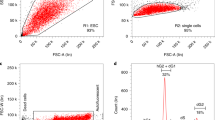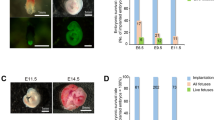Summary
Fertilized mouse eggs, heterozygous for two allozymes of glucose phosphate isomerase (GPI) were bisected, and the resulting half eggs were diploidized with cytochalasin B. After separate aggregation with normal embryos carrying a third allozyme of GPI, the resulting chimaeras were kept in culture up to 10 days. The majority grew out on the culture dish during this period. By GPI analysis, 7.7% of the embryos were found to be chimaeric. Both types of uniparental cells, from gynogenetic and from androgenetic half eggs, were capable of surviving in chimaeras in vitro. These results are comparable with published data obtained by using uniparental embryos generated by micromanipulation.
Similar content being viewed by others
References
Anderegg C, Markert CL (1986) Successful rescue of microsurgically produced homozygous uniparental mouse embryos via production of aggregation chimeras. Proc Natl Acad Sci USA 83:6509–6513
Barton SC, Surani MAH (1983) Microdissection of the mouse egg. Exp Cell Res 146:187–191
Clarke HJ, Varmuza S, Prideaux VR, Rossant J (1988) The developmental potential of parthenogenetically derived cells in chimeric mouse embryos: implications for action of imprinted genes. Development 104:175–182
Eppig J, Kozak LP, Eicher EM, Stevens LC (1977) Ovarian teratomas in mice are derived from oocytes that have completed the first meiotic division. Nature 269:517–518
Fulton BP, Whittingham DG (1978) Activation of mammalian oocytes by intracellular injection of calcium. Nature 273:149–151
Hillman N, Sherman MI, Graham C (1972) The effect of spatial arrangement on cell determination during mouse development. J Embryol Exp Morphol 28:263–278
McGrath J, Solter D (1986) Nucleocytoplasmic interactions in the mouse embryo. In: Wylie CC (ed) Determinative Mechanisms in Early Development, vol 97[Suppl]. The Company of Biologists, Cambridge, pp 277–289
Mintz B (1971) Allophenic mice of multi-embryo origin. In: Daniel JC (ed) Methods in mammalian embryology. Freeman, USA, pp 186–214
Monk M, Ansell J (1976) Patterns of lactic dehydrogenase isozymes in mouse embryos over the implantation period in vivo and in vitro. J Embryol Exp Morphol 36:653–662
Otani H, Yokoyama M, Nozawa-Kimura S, Tanaka O, Katsuki M (1987) Pluripotency of homozygous-diploid mouse embryos in chimeras. Dev Growth Differ 29:373–380
Petzoldt U, Muggleton-Harris A (1987) The effect of the nucleocytoplasmic ratio on protein synthesis and expression of a stagespecific antigen in early cleaving mouse embryos. Development 99:481–491
Solter D (1988) Differential imprinting and expression of maternal and paternal genomes. Annu Rev Genet 22:127–146
Stevens LC (1978) Totipotent cells of parthenogenetic origin in a chimaeric mouse. Nature 276:266–267
Surani MAH, Barton SC, Kaufman MH (1977) Development to term of chimaeras between diploid parthenogenetic and fertilized embryos. Nature 270:601–603
Surani MAH, Barton SC, Norris ML (1987) Experimental reconstruction of mouse eggs and embryos: an analysis of mammalian development. Biol Reprod 36:1–16
Surani MAH, Barton SC, Howlett SK, Norris ML (1988) Influence of chromosomal determinants on development of androgenetic and parthenogenetic cells. Development 103:171–178
Tarkowski AK (1977) In vitro development of haploid mouse embryos produced by bisection of one-cell fertilized eggs. J Embryol Exp Morphol 38:187–202
Tarkowski AK, Rossant J (1976) Haploid mouse blastocysts developed from bisected zygotes. Nature 259:663–665
Thomson JA, Solter D (1988) The developmental fate of androgenetic, parthenogenetic and gynogenetic cells in chimeric gastrulation mouse embryos. Genes Dev 2:1344–1351
Thomson JA, Solter D (1989) Chimeras between parthenogenetic or androgenetic blastomeres and normal embryos: allocation to the inner cell mass and trophectoderm. Dev Biol 131:580–583
Whittingham DG (1971) Culture of mouse ova. J Reprod Fertil 14:7–21
Author information
Authors and Affiliations
Rights and permissions
About this article
Cite this article
Koch-Albrecht, T., Petzoldt, U. In vitro survival of cells derived from isodiploid uniparental half embryos of the mouse after aggregation with normal embryos. Anat Embryol 182, 503–507 (1990). https://doi.org/10.1007/BF00178917
Accepted:
Issue Date:
DOI: https://doi.org/10.1007/BF00178917




